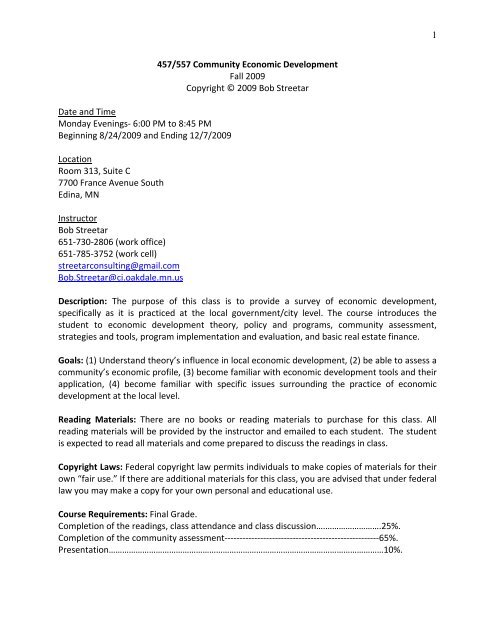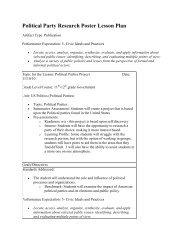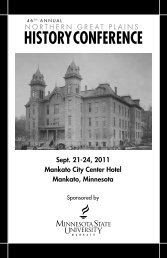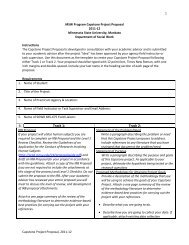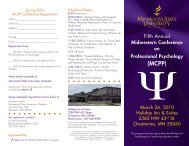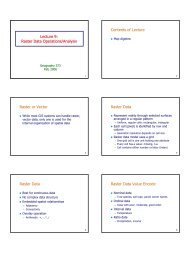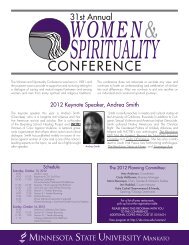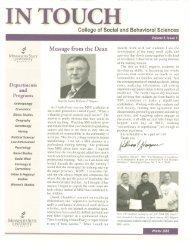Bob Streetar
Bob Streetar
Bob Streetar
You also want an ePaper? Increase the reach of your titles
YUMPU automatically turns print PDFs into web optimized ePapers that Google loves.
Date and Time<br />
Monday Evenings‐ 6:00 PM to 8:45 PM<br />
Beginning 8/24/2009 and Ending 12/7/2009<br />
Location<br />
Room 313, Suite C<br />
7700 France Avenue South<br />
Edina, MN<br />
Instructor<br />
<strong>Bob</strong> <strong>Streetar</strong><br />
651‐730‐2806 (work office)<br />
651‐785‐3752 (work cell)<br />
streetarconsulting@gmail.com<br />
<strong>Bob</strong>.<strong>Streetar</strong>@ci.oakdale.mn.us<br />
457/557 Community Economic Development<br />
Fall 2009<br />
Copyright © 2009 <strong>Bob</strong> <strong>Streetar</strong><br />
Description: The purpose of this class is to provide a survey of economic development,<br />
specifically as it is practiced at the local government/city level. The course introduces the<br />
student to economic development theory, policy and programs, community assessment,<br />
strategies and tools, program implementation and evaluation, and basic real estate finance.<br />
Goals: (1) Understand theory’s influence in local economic development, (2) be able to assess a<br />
community’s economic profile, (3) become familiar with economic development tools and their<br />
application, (4) become familiar with specific issues surrounding the practice of economic<br />
development at the local level.<br />
Reading Materials: There are no books or reading materials to purchase for this class. All<br />
reading materials will be provided by the instructor and emailed to each student. The student<br />
is expected to read all materials and come prepared to discuss the readings in class.<br />
Copyright Laws: Federal copyright law permits individuals to make copies of materials for their<br />
own “fair use.” If there are additional materials for this class, you are advised that under federal<br />
law you may make a copy for your own personal and educational use.<br />
Course Requirements: Final Grade.<br />
Completion of the readings, class attendance and class discussion….…………………….25%.<br />
Completion of the community assessment‐‐‐‐‐‐‐‐‐‐‐‐‐‐‐‐‐‐‐‐‐‐‐‐‐‐‐‐‐‐‐‐‐‐‐‐‐‐‐‐‐‐‐‐‐‐‐‐‐‐‐‐65%.<br />
Presentation……………………………………………………………………………………………………………10%.<br />
1
Be Courageous: I encourage you to share your thoughts in class. All different perspectives are<br />
welcome. Sharing your opinion with your classmates is what makes the class fun and<br />
interesting.<br />
AUGUST 24<br />
Introduction and Overview<br />
Class Overview<br />
• Syllabus Overview<br />
• Class Project – Community Economic Assessment<br />
Class Assignment ‐ Assessment of Local Economy<br />
• Koven, Steven G., & Lyons, Thomas, S. (2003). Economic Development: Strategies for State<br />
and Local Practice. International City/County Management Association, Washington, DC. Ch.<br />
6,”Understanding the Local Environment,” p. 165‐183.<br />
• Ebenhoh, James, Meek, Stuart & Moore, Terry. (2006). An Economic Development Toolbox:<br />
Strategies and Methods. American Planning Association, Chicago. Ch. 3 “Evaluating a Local<br />
Economy,” p. 11‐31.<br />
• Community Economic Analysis: A How To Manual<br />
Hustedde, R. J., R. Shaffer, and G. Pulver. Revised 2005. Community Economic Analysis: A How<br />
To Manual. (RRD186). Ames, IA: North Central Regional Center for Rural Development. ISBN<br />
0‐936913‐15‐1. http://www.ncrcrd.iastate.edu/pubs/contents/186.htm<br />
• List of informational resources for assessment of local economy.<br />
• City of Oakdale Community Assessment<br />
AUGUST 31<br />
Context of Economic Development<br />
• Kuttner, Robert. (1996). Everything for Sale: The Virtues and Limits of Markets. University of<br />
Chicago Press, Chicago. Ch. 1, “The Resurgent Market”, p. 1‐38.<br />
• Okun, Arthur, M. (1975). Equality and Efficiency: The Big Trade Off. The Brookings Institution,<br />
Washington, D.C., Ch. 2, “The Case for the Market,” p. 32‐51.<br />
• Blair, John. (1995). Local Economic Development. SAGE Publications, Thousand Oaks, CA. Ch<br />
1. “Economic Development and Market Logic”, p. 1‐14<br />
• Lindbloom, Charles. (2002). The Market System: What it is, How it Works, and What to Make<br />
of it. Yale University Press, New Haven. Ch. 1, “The Market System Ascendant,” p. 1‐15, Ch. 2,<br />
“Society’s Coordination,” p. 19‐34, Ch. 3, “Market System Coordination,” p. 33‐51, Ch. 11,<br />
“Inefficiencies,” p. 147‐165.<br />
2
SEPTEMBER 7<br />
NO CLASS<br />
SEPTEMBER 14<br />
Economic Development Theory and Policy<br />
• Eisinger, Peter. (1988). The Rise of the Entrepreneurial State. The University of Wisconsin<br />
Press, Wisconsin. Ch. 2, “The Framework of Economic Development Policy,” p. 15‐33., Ch. 3,<br />
“Justifying Economic Development,” p. 34‐54.<br />
• Fitzgerald, Joan & Green Leigh, Nancy (2002). Economic Revitalization: Cases and Strategies<br />
for City and Suburbs. SAGE Publications, Thousand Oaks, CA. Ch. 1, “Redefining the Field of<br />
Local Economic Development,” p. 9‐38.<br />
• Blakely, Edward, & Bradshaw, Ted. (2002). Planning Local Economic Development: Theory and<br />
Practice. SAGE Publications, Thousand Oaks, CA. Ch. 1, “A New Argument for Taking Local<br />
Economic Development Initiatives,” p. 1‐26<br />
• Bartik, Timothy, J., (1990). The Market Failure Approach to Economic Development. Economic<br />
Development Quarterly. Vol.4, No. 4.<br />
Economic Base Theory<br />
• Feser, Edward, J., & Malizia, Emil, E. (1999). Understanding Local Economic Development.<br />
Center for Urban Policy Research, New Brunswick, New Jersey. Ch. 3, “Economic Base<br />
Theory”, p. 51 – 64.<br />
• Ebenhoh, James, Meek, Stuart & Moore, Terry. (2006). An Economic Development Toolbox:<br />
Strategies and Methods. American Planning Association, Chicago. Ch. 3. “Evaluating the Local<br />
Economy.” p. 19‐20., Appendix A. “Using Economic Base and Shift‐Share Analysis to Analyze<br />
the Regional Economy”, p. 62‐63.<br />
SEPTEMBER 21<br />
Economic Development Theory and Policy<br />
• Bolton, Roger. (1992). “Place Prosperity vs. People Prosperity.” Urban Studies, Vol. 29, No. 2<br />
Cluster Theory<br />
• Porter, Michael<br />
E. (2003). “Locations, Clusters, and Company Strategy.” The Oxford Handbook<br />
of Economic Geography. Oxford University Press, UK. p.253‐274.<br />
T rade Theory<br />
• Feser, Edward,<br />
J., & Malizia, Emil, E. (1999). Understanding Local Economic Development.<br />
Center for Urban Policy Research, New Brunswick, New Jersey. Ch. 7, “Trade Theory” p. 150‐<br />
173.<br />
3
• Columbia<br />
Heights Industrial Park Redevelopment (Presentation)<br />
SEPTEMBER<br />
28<br />
Economic Development<br />
Theory and Policy<br />
• Bingham, Richard, D. (1998). Industrial Policy<br />
American Style. M.E. Sharpe, New York. Ch. 2<br />
“In the Beginning: America’s Long History of Industrial Policy.” p.21‐42.<br />
Product Cycle Theory<br />
• Feser, Edward, J., & Malizia, Emil, E. (1999). Understanding Local Economic Development.<br />
Center for Urban Policy Research, New Brunswick, New Jersey. Ch. 8, “Product Cycle Theory”<br />
p. 174‐194.<br />
E ntrepreneurship Theory<br />
• Feser, Edward, J., & Malizia,<br />
Emil, E. (1999). Understanding Local Economic Development.<br />
Center for Urban Policy Research, New Brunswick, New Jersey. Ch. 7, “Trade Theory” p. 195‐<br />
221.<br />
• Retail Trade Analysis – Adeel Ahmend, University of Minnesota Extension<br />
(City of Oakdale 2007 Retail Trade Analysis)<br />
OCTOBER<br />
5<br />
Economic Development<br />
Strategies and Tools<br />
• Isserman, Andrew M. (1993). “State Economic<br />
Development Policy and Practice in the United<br />
States: A Survey Article.” International Regional Science Review, Vol. 16, p. 49‐100.<br />
• Clark, Susan, & Gaile, Gary. (1992). Approaches to Economic Development. The Next Wave:<br />
Postfederal Local Economic Development Strategies. Economic Development Quarterly. Vol. 6,<br />
No. 2. p. 165‐177.*<br />
• Eisinger, Peter. (1995). Approaches to Economic Development. State Economic Development<br />
in the 1990s. Politics and Learning. Economic Development Quarterly. Vol. 9, No. 2. p.178‐<br />
190.*<br />
• Koven, Steven G., & Lyons, Thomas, S. (2003). Economic Development: Strategies for State<br />
and Local Practice. International City/County Management Association, Washington, DC. Ch.<br />
2,”Tools of Economic Development,” p. 25‐56<br />
• American Planning Association. Strategies for Economic Development. (Handout)<br />
• Columbia Heights Industrial Park Redevelopment (Presentation‐Option)<br />
4
OCTOBER 12<br />
Economic Development<br />
Practice<br />
• Blakely, Edward. & Bradshaw, Ted. (2002). Planning Local Economic Development. Sage<br />
Pubications, California. Ch. 14., “The Local Economic Development Profession and<br />
Professionals.” p. 375‐385.<br />
• Spitzley,<br />
David & Wolman, Harold. (1996). The Politics of Local Economic Development.<br />
Economic Development Quarterly, Vol. 10, No. 2, May 1996. p. 225‐262.<br />
• Levy, John. (1990). What Local Economic Developers Actually Do: Location Quotients Versus<br />
Press Releases. Journal of the American Planning Association. Vol. 56, Issue 2.<br />
• Professional Economic Development and Related Organizations<br />
• Columbia Heights Industrial Park Redevelopment (Presentation‐Option)<br />
OCTOBER<br />
19<br />
Economic Development<br />
Practice<br />
• Malpezzi, Stephen. (2003). Local<br />
Economic Development and Its Finance. In Financing<br />
Economic Development in the 21 st Century. M.E. Sharpe, Inc., New York. Ch. 1. “Local<br />
Economic Development and its Finance: An Introduction,” p. 1‐26.<br />
• Shoettle,<br />
Ferdinand. (2003). Local Economic Development and Its Finance. In Financing<br />
Economic Development in the 21 st Century. M.E. Sharpe, Inc., New York. Ch. 2. “What Public<br />
Do State Constitutions Allow?” p. 27‐49.<br />
• Ledebur, Larry,& Woodward, Douglas. (2003). Local Economic Development and Its Finance.<br />
In Financing Economic Development in the 21 st Century. M.E. Sharpe, Inc., New York. Ch. 4.<br />
“Adding a Carrot to the Stick: Location Incentives with Clawbacks, Recisions, and<br />
Recalibrations,” p. 70‐91.<br />
• Peters, Alan, & Fisher, Peter. (2003). Local Economic Development and Its Finance. In<br />
Financing Economic Development in the 21 st Century. M.E. Sharpe, Inc., New York. Ch. 6.<br />
“Enterprise Zone Incentives: How Effective Are They?” p. 113‐130.<br />
• Lynch , Robert, G. (2004). Rethinking Growth Strategies. Economic Policy Institute. Executive<br />
Summary, p. vii, Introduction, p. 1, Ch. 1, “Common arguments for state and local tax cuts and<br />
incentives,” p. 3‐12., Ch. 2, “An overview of the literature on state and local tax cuts and<br />
incentives,” p. 19‐20., Ch. 6, “The effects of state and local public services on economic<br />
development,” p. 43‐46, Ch. 7, “Conclusions: The policy implications of state and local taxes.”<br />
p. 47‐48.<br />
5
• LeRoy, Gregg. (2005). The Great American Jobs Scam., Berrett‐Koehler Publishers, Inc.,<br />
Californian., Ch. 2., “Site Location 101: How Companies Decide Where to Expand or<br />
Relocation,” p. 47‐67<br />
OCTOBER 26<br />
Real Estate Finance<br />
No Readings – Instructor Presentation<br />
• Basic Real Estate Finance<br />
• Tax Increment Financing<br />
• Tax Abatement<br />
• JobZ<br />
NOVEMBER 2<br />
Real Estate Finance<br />
No Readings – Instructor Presentation<br />
• Basic Real Estate Finance<br />
• Tax Increment Financing<br />
• Tax Abatement<br />
• JobZ<br />
NOVEMBER 9<br />
Real Estate Finance<br />
No Readings – Instructor Presentation<br />
• Basic Real Estate Finance<br />
• Tax Increment Financing<br />
• Tax Abatement<br />
• JobZ<br />
NOVEMBER 16<br />
Economic Development Planning and Implementation<br />
• Ebenhoh, James, Meek, Stuart & Moore, Terry. (2006). An Economic Development Toolbox:<br />
Strategies and Methods. American Planning Association, Chicago. Ch. 4 “Selecting and<br />
Implementing Local Economic Development Strategies,” p. 33‐59.<br />
• Blakely, Edward, & Bradshaw, Ted. (2002). Planning Local Economic Development: Theory and<br />
Practice. SAGE Publications, Thousand Oaks, CA. Ch. 4, “The Local Economic Development<br />
Planning Process.,” p. 75‐102.<br />
• Shaffer, Ron., Deller, Steve., & Marcouller, Dave., (2004). Community Economics. Blackwell<br />
Publishing, Iowa. Ch. 12. “Policy Modeling and Decision Making.” p. 202‐223., Ch. 13. “The<br />
Practice of Community Economic Development.” p. 224‐257.<br />
6
NOVEMBER 23<br />
Policy/Program Evaluation<br />
• Dewar, Margaret. (1998). Why State and Local Economic Development Programs Cause so<br />
Little Economic Development. Economic Development Quarterly, Vol. 12, No. 1: p. 68‐77.<br />
• Fasen, David & Reese, Laura. (1996). What Works Best? : Values and the Evaluation of Local<br />
Economic Development Policy. Economic Development Quarterly, Vol. 11, No. 3, August 1997.<br />
p. 278 – 291.<br />
• Bartik, Timothy J., & Bingham, Richard, D. (1997). Can Economic Development Programs Be<br />
Evaluated? In Richard D. Bingham and Robert Mier, ed., Dilemas of Urban Economic<br />
Development. Thousand Oaks, CA: Sage. Ch. 10, p. 246‐277.<br />
NOVEMBER 30<br />
Individual Presentations<br />
DECEMBER 7<br />
Individual Presentations<br />
7


